Fig. 1. Stone vessel materials used over ancient Egyptian history (Aston 1994, Lilyquist 1995, Nicholson & Shaw 2000)
Stone Vessel Making
Stone vessels were one of the most common items of funerary equipment used by the ancient Egyptians. The oldest examples are found in Lower Egypt at the settlement of Merimde Beni Salamais, dating to the Merimden period over 6000 years ago, and exhibit a low level of technical competency in their manufacturing (Hoffman 1979). During the rest of the Predynastic period (c. 4000-3000 BC) the quality of the manufacturing increased dramatically. The late Predynastic period of Upper Egypt was generally characterized by an increasing shift away from pottery of fine craftsmanship to stone vessels for use in tombs. This may reflect a shift in the direction of consumer demands of the elite, with an emphasis on exotic luxury goods for the afterlife, and the increasing economic difference between the ruling class and the rest of the populous (Hoffman 1979). As a result stone vessel manufacturing reached a high level of technical competency during the Early Dynastic (c. 3000-2700 BC) and Old Kingdom (c. 2700-2200 BC) periods, were they were made in very large numbers. After the Old Kingdom, stone vessels continued to be made, but on a much lesser scale.
A wide variety of different rocks and mineral were employed in their manufacture, and these materials often varied over time as availability and aesthetics changed (Fig. 1). The rocks and minerals came from numerous sources throughout Egypt, and some types were imported from afar, such as obsidian and lapis lazuli (Nicholson & Shaw 2000). These raw materials were either collected as eroded debris or quarried from rock outcrops. The majority of vessels were made of carbonate rocks, such as travertine (Egyptian alabaster), limestone, limestone breccia, and dolomite, smaller numbers were made of other rocks and mineral.
The earliest materials used were limestone, basalt, travertine, limestone breccia, and hornblende diorite during the early Predynastic period (Aston 1994). The Early Dynastic period exhibits a wide degree of experimentation with different types of stone, including vein quartz, which was the hardest material worked by the ancient Egyptians into vessels (Lucas & Harris 1962). The more exotic rocks and minerals, as well as the harder and more expensive to work material were restricted mainly to royal tombs. Although, more common and easier to work rocks like limestone, travertine, and alabaster were used for great numbers of vessels in royal tombs, they were by far the main materials used in non-royal tombs.Fig. 1. Stone vessel materials used over ancient Egyptian history (Aston 1994, Lilyquist 1995, Nicholson & Shaw 2000)
The range of stylistic forms were quite varied. Many are original in design (Fig. 2), or representations of foreign designs (Fig. 3), some are common to pottery (e.g. UC41108), to basket-work (e.g. UC35654, UC36986, UC36987), and even to metal vessels (e.g. a stone vessel with simulated rivet-heads (Lauer 1976, pl. 109)). Others appear to be fantasies on the part of the craftsmen (Fig. 4), or stone representations of certain useful objects made of fragile or perishable materials for use in the afterlife (e.g. UC35727). Stone vessel forms were sometimes imitated in pottery (Fig 5b), such as that expressed in the spiral and zigzag line decorations (Fig 5a) representing the mottled appearance of limestone breccia (Bourriau 1981). Many of these vessels are remarkable for both perfection of workmanship and purity of stylistic form, which is especially true in the case of hardrock vessels.
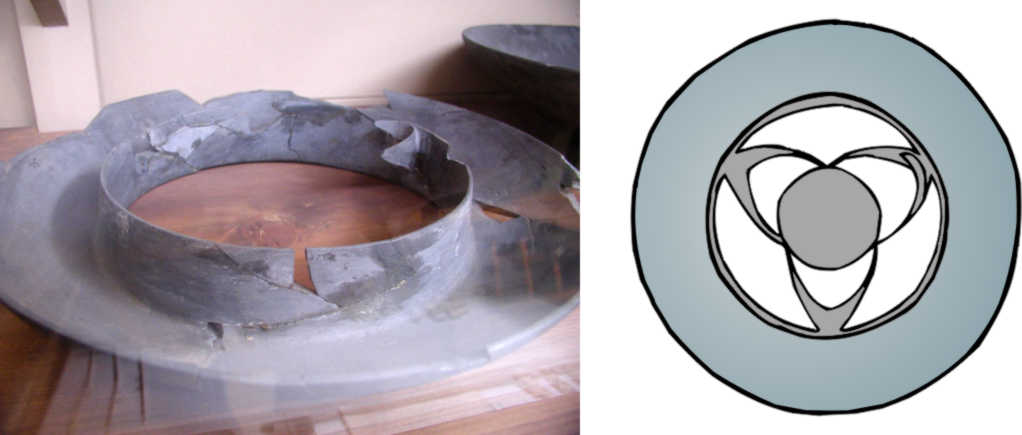
Fig. 2. Metasiltstone ornamental toilet tray and representation of missing center portion (after El-Khouli 1978), 1st Dynasty. (Cairo Museum, Photograph by Jon Bodsworth The Egypt Archive)

Fig. 3. Basalt footed jar with perforated handles from the Nagada I period and thought to be originally a Mesopotamian design common to pottery (Adams 1988) (height c. 28 cm, Musee de Louvre, Paris. Photograph by Jon Bodsworth The Egypt Archive)

As well, Petrie (c1977) describes what he called "evasion of the difficulty" in the working of some stone vessels, which began to occur during the 0-1st Dynasties. This is characterized by the cutting the stone vessel into sections so that the interior could be easily hollowed and the sections then glued back together, this was continued to the 12th Dynasty (Fig 6a); cutting a hole through the bottom of the vessel to allow easy access to the interior for grinding, in which the hole was later plugged with a disk of rock (Petrie c1970); the manufacturing of imitation vessels made of blue glass paste to simulate lapis lazuli, and black mud with fragments of white limestone to simulate andesite porphyry (Petrie c1977; c1970), and the ancient Egyptians sometimes did not hollow vessels out completely, or at all, which became more common later in their civilization (Fig. 6b).Fig. 4. Theriomorphic vessel in shape of a bird made of limestone breccia, Late Predynastic-early 1st Dynasty c. 3100 BC. (British Museum (BM35306), Photograph by Jon Bodsworth The Egypt Archive)
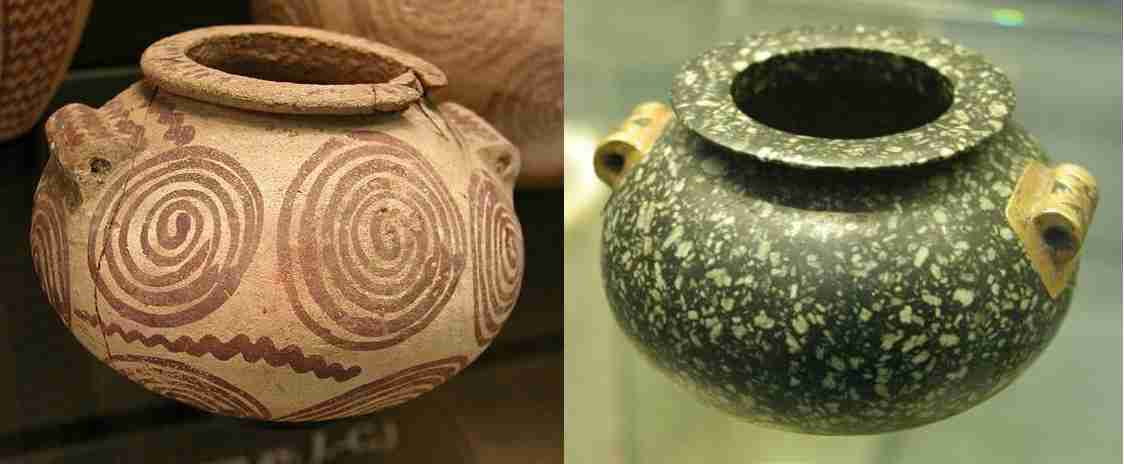
Fig. 5. a) Ceramic pot from the Nagada II period (Gerzean culture) with spiral pattern imitation of limestone breccia (height c.10 cm, Musee de Louvre, Paris. Photograph by Jon Bodsworth The Egypt Archive) b) Andesite porphyry, squat jar with gold-leafed, tubular handles from the 1st or 2nd Dynasty 3100-2686 BC. (height. c. 10 cm, British Museum (BM) Photograph by Jon Bodsworth The Egypt Archive)
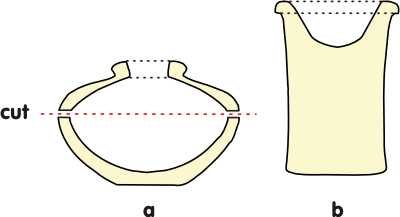
The shapes of forms, as well as, the materials used for vessels changed over time, which makes stone vessels a useful tool for dating archeological sites (Date range of cylindrical beakers). The size of stone vessels range from quite small, on the order of a few centimeters in height (e.g. 4.4 cm UC17010, 3.4 cm UC31515, 2.9 cm UC41251), to large (Fig. 7).Fig. 6a) Cross-section of travertine vessel cut in two halves from the late Dynasty 0 (after Petrie c1977). b) Cross-section of alabaster (gypsum) cylinder vase with perfunctory hollowing from the late Dynasty 0 (after Petrie c1977).
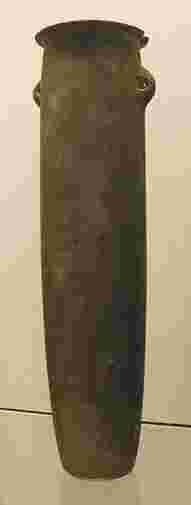
The places were stone vessels were made are dependant on the materials used. At the gypsum quarries at Umm el-Sawwan there are many examples of unfinished vessels and some of the chert tools used to carve them (Caton-Thompson & Gardner 1934). Many other quarry sites have little evidence of on site carving, suggesting that the rock was quarried or collected and transported to workshops, where it was transformed into vessels and other objects. The remains of numerous storerooms and workshop complexes for metal working, butchering, and stone vessel manufacturing have been found in the Early Dynastic and Old Kingdom town of Hierakonpolis dating from about 2800 to 2200 BC (Quibell & Green 1902), and a model stone vessel workshop has been found from an estate, dated about 3080 BC during the reign of King Aha at Saqqara (El-Khouli 1978, pl. 147).Fig. 7. Predynastic period (Nagada I) basalt vase (height: 42.8 cm, Musee de Louvre, Photograph by Jon Bodsworth The Egypt Archive).
Shaping of the Vessel's Form
Most rocks can be carved by percussion, which involves striking the rock with sufficient pressure to crush the mineral grains on its surface. Today, rock can be shaped to a fine scale by this method with the use of bush hammers, which are made of soft tool steel or cast iron (Rich 1970). Stone hammers and other such tools will also work, as long as the stone being carved has a lower rock hardness than that of the tool, and the fracture toughness of the mineral grains in the rock being carved are not too high. Other types of tools made of flint, such as pecking hammers, work as a result of the combination of the indentation hardness of quartz and the brittle nature of the rock flint. As the flint tool is struck against a rock's surface, its sharp edges cut into the mineral grains and the end of the tool fractures producing new sharp edges. Repeated quick striking of the rock's surface with such a tool effectively wears away minerals with lower indentation hardness and fracture toughness than quartz (such as feldspar in granite, leaving the quartz grains exposed and more easily undercut and removed by crushing with a stone hammer). The durability of stone tools is less than their modern equivalents made of metal, and as a result, more frequent replacement would be necessary during use.
As a result of high impact stresses sustained by stone percussion tools during use, hardrocks of igneous, metamorphic, and sedimentary composition are preferable as the material of manufacturing of these tools. The ancient Egyptians routinely worked such rocks into axeheads (e.g. UC2661, UC2674, UC2579, UC3617), maceheads (e.g. UC15399), and adzes (e.g. UC13787) in Upper and Lower Egypt during the early Predynastic period (Hoffman 1979). Many of the skills developed during early stone tools manufacturing could be used in the manufacturing of stone vessels, as well as other stone objects such as statues. For example, the similarities in the symmetrical shape and the hollowing of the center in both early maceheads and stone vessels is quite evident (Fig. 8).

Much of the rough shaping of the stone vessels by the ancient Egyptians could be accomplished with simple hand-powered percussion and lapidary tools. The ancient Egyptian's choice of tools would depend on the type of rock used in the vessel, the amount of waste rock that needed to be removed from the initial block of stone, and the vessel's form. Percussion tools may consist of metal chisels (hardened copper (cold-worked and arsenic alloy) or bronze, e.g. UC7240, Fig. 9) for use on most softrocks, such as porous limestone (Stocks 1999), and stone mauls (e.g. UC30858, UC30184, UC16328), hammerstones (e.g. UC44234), pecking hammers, pounders (e.g. UC27323, UC35981, UC379, UC21411), chisels, and punches for both softrocks and hardrocks. (Engelbach 1923, Zuber 1956, Stocks 1986a; 1999). The process of working porous limestone and similar rocks is easily done with these tools, however, carving igneous rocks like granite is a slow process (Stocks 1999). Examples of unfinished stone vessel exhibiting marks from percussion tools are also known (Fig. 10, e.g. UC36879, UC6934, UC33304, UC33306, UC33307, UC33308, UC33310, UC33311). Zuber (1956) conducted an experiment in the use of flint percussion tools to carve a small Egyptian style bust in granite, it took approximately 36 hours to complete the carving of the statue's form, but involved no polishing of the surface. Stocks (2001) conducted hieroglyphic carving experiments in granite using hammer-driven flint chisels and obtained a rate of 5 cm3 per hour of rock removal. Engelbach (1923) conducted granite quarrying experiments using diabase (dolerite) pounders at Aswan and obtained rates of 450 cm3 per hour of rock removal.Fig 8. Disc-shaped stone maceheads from El-Mahasna of early Predynastic date, Naqada I, c. 4000-3600 BC. (left, diameter c. 10 cm, British Museum (EA 49003), Photograph by Jon Bodsworth The Egypt Archive)
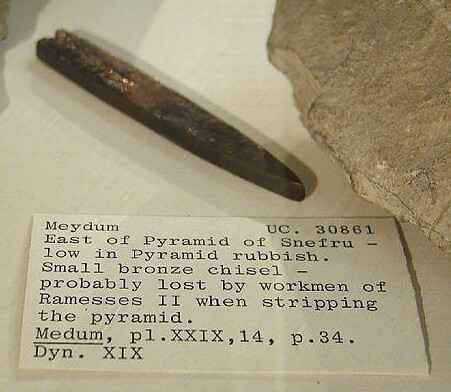
Fig. 9. Small bronze chisel (UC30861) without handle for use as a hand graver, 19th Dynasty. (The Petrie Museum, Photograph by Jon Bodsworth The Egypt Archive)
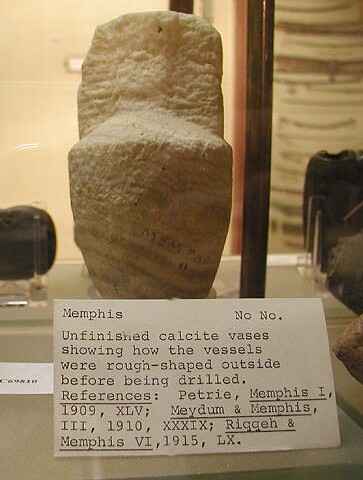
Lapidary tools such as hand- or bow-powered slabing saws and coring drills are very useful for the removal of waste rock, and in the shaping of complex and delicate shapes in stone. An example of a partially completed granodiorite porphyry vessel, on display in the Cairo Museum (JE18758), demonstrates how a coring drill could be used to remove waste rock in the manufacturing of stone vessels (Stocks 1999, image 1, image 2, image 3, image 4, image 5). Eight core holes can be observed with 7 closely spaced around the perimeter of the bowl's inner surface, and one in the center. This method of removing waste rock reduces the effort necessary for the manufacturing of stone vessels from blocks of stone, and is a common timesaving technique still used today. An example of the faceting of a small unfinished statuette of vein quartz demonstrates the removal of waste rock and the rough shaping of the front and sides by the use of a small lapidary saw (e.g. UC16617, Petrie c1974). In materials like vein quartz, only lapidary tools can be used, since percussion will lead to fracturing of the rock's interior, which makes it more difficult to work and the surface less appealing when completed. Stone rubbers and scrapers can also be useful grinding tools for shaping both hardrocks and softrocks.Fig. 10. Unfinished travertine vessel exhibiting tool marks from rough-shaping. (The Petrie Museum, Photograph by Jon Bodsworth The Egypt Archive)
Turning has also been suggest as a method used to shape stone vessels by the ancient Egyptians (Petrie 1883, c1970). Petrie (1883, e-book section 132) gives two examples as evidence of lathe-turned objects:
a) Fragment of diorite bowl, showing evidence in the form
of a off-centered cusp from use of a lathe tool (e.g. Drawing
#14)
b) Rim fragment of anorthosite gneiss bowl showing evidence
in the form of a cusp from use of a lathe tool, 4th Dynasty (e.g.
UC16042,
Drawing
#15)
Petrie (c1977) states that Predynastic stone vessels exhibit markings consistent with grinding in a up and down direction, and it is in the Early Dynastic that the circular tool marks that suggest turning in a block begin to appear (Fig. 11). The quality of early Predynastic stone vessels demonstrates the ability of the ancient Egyptians to produce symmetrical vessels in stone and that it existed prior to the development of a possible lathe-like tool (Fig. 7). The ability of the ancient Egyptians to produce symmetrical shapes without a lathe is also demonstrated in their ability to carve fine statuary in a variety of complex forms. However, the only prerequisites for a lapidary lathe and other simpler devices is that the object being worked and the grinding tools be held ridged as the object is rotated. This does not have to be a high-speed or high-pressure type tool, only enough pressure to cause abrasion between the grinding surface and the object being worked is needed. The optimum pressure for lapidary cutting using quartz abrasive is < 1 kg/cm2 (Stocks 2001). Such tools may involve the adaptation of a turntable (slow-wheel), potter's wheel, or the bow-drill. The object being worked could be placed on pivots and hand-rotated, or the bow drill could be modified into a partial rotary pole-lathe. Pole-lathes are tools that rotate the object back and forth rather than spinning it. If a primitive lathe was used by the ancient Egyptians, it might be expected that in most cases it was used as a finishing tool for fine dressing the vessel's form. All the rough shaping would be done by percussion and other types of lapidary techniques, since in most cases the removal of waste rock is more efficient and less time consuming by these methods. The lack of pivot holes on stone vessels is a problem (Fig. 14), although these may have been removed during finishing of the vessel's outer surface.

The striations on such objects as the above basalt cup may also be explained by the rotation of the tool as the vessel is held in place. Modification of the end of a coring drill barrel into a tapered cone could be used to produce various shapes by lapidary grinding, while the end of the rotating tool is pressed down onto the stationary stone object being worked. As we see below (Fig. 22-23) the boring tool used to hollowing the interior of stone vessels is also capable of making cusp-shaped ridges as well.Fig. 11. Old Kingdom basalt cup (UC42075) exhibiting circular striations. (height c. 8 cm. The Petrie Museum, Photograph by Jon Bodsworth The Egypt Archive) Note: Higher Res. image.
The use of a primitive lathe in woodworking (Fig. 12) appears from some evidence that it could have been used before Greco-Roman times, but was very limited and restricted to primitive pole-lathes or just wood held in pivots and rotated by hand as it was sanded (Lucas & Harris 1962). A small 12 Dynasty lid (e.g. UC7123) exhibits a center hole, which may have been used for a pivot, but the hole for a handle may not be ruled out (Nicholson & Shaw 2000). A number of New Kingdom stool legs also show the possible use of a primitive lathe in their manufacture, although this may also be the result of other methods (Manuelian 1981).

Fig. 12. Earliest known representation of the use of a woodworking lathe in the tomb of Petosiris from the early Ptolemaic period (after Nicholson & Shaw 2000).
As of yet no tubular barrels made of copper or the wooden drill-shaft used for coring of rock have been found in the archeological record from ancient Egypt, Crete, or Mesopotamia where rock coring and stone vessel making was employed (Warren 1969, Stocks 1993). For the copper barrel, this may be due to the wearing down of the copper tube to lengths that were no longer usable, at which point the remaining copper tube was recycled (Stocks 1993). The use of bow- and hand-powered coring drills (Fig. 13) as a method of cutting rock is inferred from marks observed on ancient Egyptian stoneworks, and includes pieces of waste rock, as well as finished and unfinished stone objects (Copper coring drills). Traces of verdigris, either copper or bronze, as well as abrasive have been found in core holes in both Egypt (Reisner 1931) and Crete (Warren 1969).
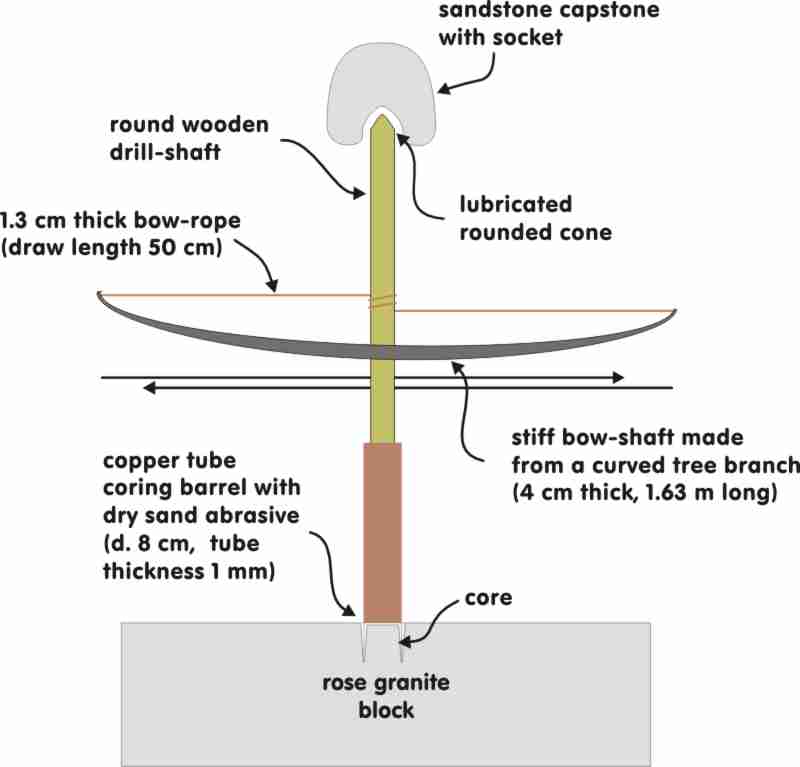
Before the introduction of the a bow- or hand-powered coring drill during the mid-Predynastic Period, holes in rocks were drilled by boring, a more time consuming practice due to the larger volume of rock that needed to be removed. The use of the coring drill as a method of removing waste rock from the vessel's intended form would have greatly increases the ancient Egyptians ability to manufacture these objects. The use of the coring drill would be dependent on the vessel's form, which are many through the long history of stone vessel production in ancient Egypt. In the case of a narrow-necked vessel (i.e. the neck opening is of smaller diameter than the vessel's interior), the coring drill is quite useful. After initial shaping of the vessel's form was completed a circle would first be marked on the top surface of the vessel and a small groove cut along it to act as a guide for the barrel of the coring drill (Fig. 14). A core hole would be cut through the center of the neck of the vessel to a depth that would allow access to the interior for the purpose of hollowing. This is similar to the methods used today by lapidist when making stone vessels (Long 1976, Can narrow-necked stone vases be made today?).Fig. 13. Representation of the ancient Egyptian coring drill used in the rock cutting experiments of Stocks (1993, 2001).
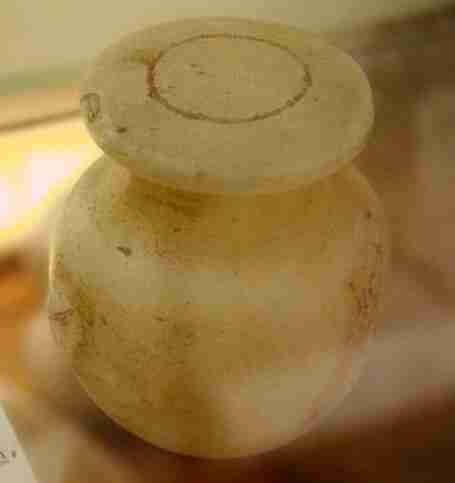
The core (e.g. UC44986, UC68247, UC44988, UC43723, UC43893, UC44987, UC44989, UC44991, UC55364) would be cut with a coring drill using an abrasive, such as quartz sand, either dry or as a slurry. The sides of the core and core hole were generally kept as parallel as possible to reduce the risk of breakage of the neck, which is often the weakest part of the vessel. The core would then be snapped out of the vessel, presumably with the add of wooden wedges and a light taping of a hammer. Sometimes the core would not break cleanly at the base of the vessel, a number of unfinished vessel exhibit this (Fig. 15, e.g. UC44992). The use of a material to coat the outer delicate surfaces of the vessel for the purpose of strengthening them, such as glue or resin soaked linen strips could also have been used, and this is also done today by modern Egyptian stone vessel makers (El-Khouli 1978). Vessels of the early 1st Dynasty date often do not contain a circular groove at the bottom of the vessel's interior, representing the depth of the coring barrel's cut. The ancient Egyptians carefully ground the groove away during the hollowing procedure. This changes by the middle of the 1st Dynasty where the ring is commonly shown (e.g. UC41273), in later times the ring became a necessity (Fig. 16, UC41210) and was even imitated by a scraped line if none already existed (Petrie c1977).Fig. 14. Unfinished travertine stone vessel marked with red paint for coring with drill, possibly 6th Dynasty (height c. 7 cm. The Petrie Museum, Photograph by Jon Bodsworth The Egypt Archive)
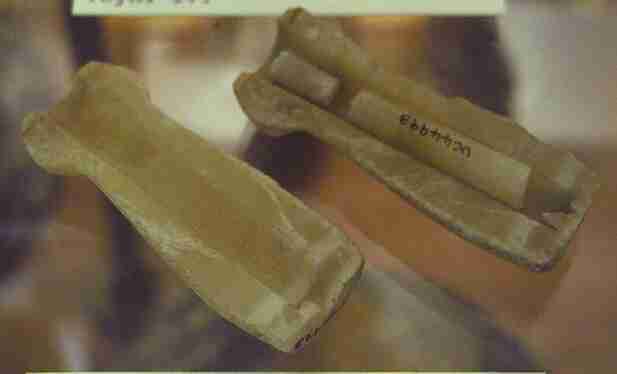
Fig. 15. Unfinished travertine stone vessel split longitudinally to reveal remaining drill core fragments partially attached, possibly 4th Dynasty (height 6.9 cm, The Petrie Museum (UC44993), Photograph by Jon Bodsworth The Egypt Archive)
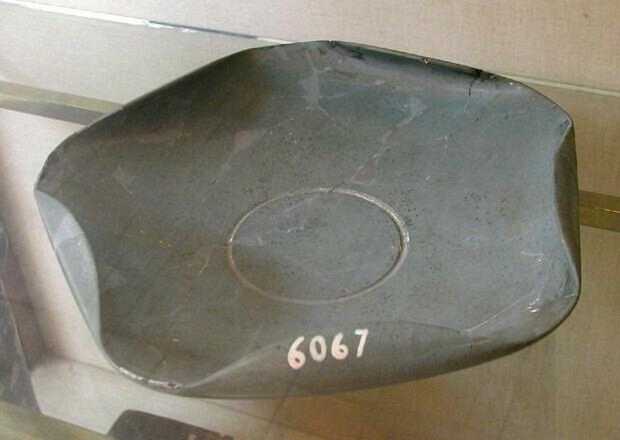
Another use of the coring drill is in the manufacturing of rock tubes and ridges. A tube cut from basalt (Fig. 17), most likely a waste fragment from the coring of another object, could be done by centering and cutting two core holes of different diameter and then detaching the tube. This is a useful method of removing larger cores, since it reduces the amount of stress necessary to break the core from the base of the core hole. Another example of tube making by the ancient Egyptians is an Early Dynastic period metasiltstone ornamental bowl, the tube is left attached and the surrounding rock is removed (Fig. 18). Stocks (1993) demonstrated the ability of hand-powered coring drill to make a rock tube in limestone during a stone vessel manufacturing experiment (see below). This is a method still used today by amateur lapidists for the making of cylindrical vessels and bracelets (Long 1976).Fig. 16. Metasiltstone ornamental bowl with coring slot from the Step Pyramid, 3rd Dynasty. (diameter 38 cm., Cairo Museum, Photograph by Jon Bodsworth The Egypt Archive)
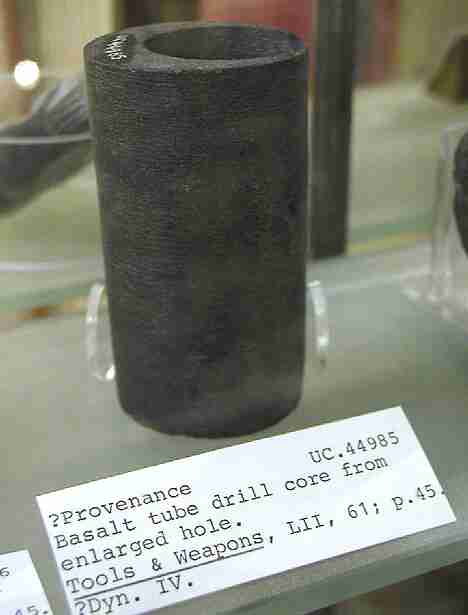
Fig. 17. Drill core waste fragment made of basalt (UC44985), double cored to producing a tube, unknown date possibly 4th Dynasty. (height: 8.3cm, The Petrie Museum, Photograph by Jon Bodsworth The Egypt Archive) Note: Higher Res. image.
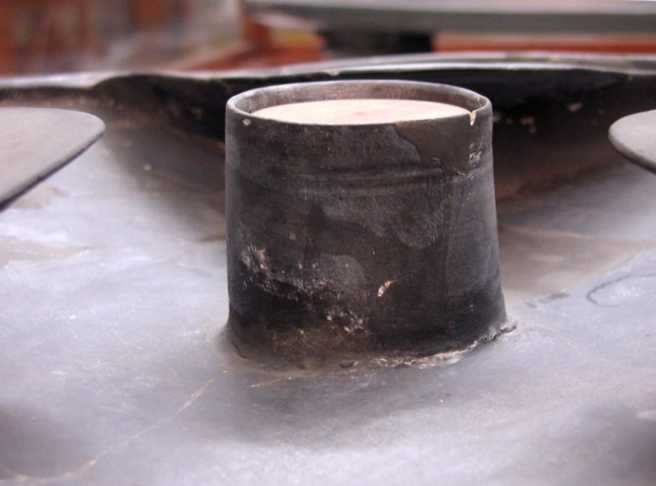
An interesting travertine tray (link) exhibits a series of raised ridges (El-Khouli 1978). These features could have been made with a number of lapidary coring bits of varying diameters to create the 3 outer ridges. To produce each of the raised ridges 2 coring bits would be needed. These bits can just be a single sheet of copper, which is attached to wooden dowels of the appropriate diameters. One bit would need its outside diameter equal to inside diameter of the ridge, and the other bit would need its inside diameter equal to the outside ridge's diameter. Properly centering and drilling (coring to a set depth in the rock's surface) in a way similar to that demonstrated in Stocks (1993) would produce a ridge of travertine. Partially coring the rock that occupies the needed groove area a number of times with bits of varying diameter could also be done, this makes this waste rock easy to removed by chiseling from the grooves. The use of a coring drill would actually be a faster and easier method then turning the object with a lapidary lathe, since less material needs to be ground away.Fig. 18. Rock tube in center of the metasiltstone ornamental bowl from the 1st Dynasty tomb of Prince Sabu (Tomb 3111 (Emery 1949)). (tube diameter 10 cm, Cairo Museum, Photograph by Jon Bodsworth The Egypt Archive)
Boring of the Vessel's Interior
The next stage in the manufacturing of stone vessels would involve the hollowing of its interior using the center core hole for access, and this was usually accomplished with stone borers of various shapes and sizes attached to a forked wooden drill shaft (Petrie c1970). The partial rotary motion of the borer's drill shaft could be engaged by a bow or twisted by hand. Stone bores have been found from ancient Egypt, but the wooden shafts have not survived. In Egypt numerous representations of the apparent use of such a tool are known from scenes depicting stone vessel manufacturing (Fig. 21a). Unfortunately, the working end of the borer is always obscured by the vessel being worked in these representations. However, the Old Kingdom period ideogram (Fig. 19a) for such words as 'craft', 'art', and 'workman' depict a forked shaft with two weights attached to its sides, after the Old Kingdom the ideogram changed (Fig. 19b) to a forked shaft lashed to a central shaft and a single circular weight (Gardiner 1964). The shaft was probably made of a tree branch of suitable shape and the weights made of stone.

The Egyptian stone borer usually consisted of an elongated figure eight shaped hardstone, which was usually flat on top and curved on the bottom (Fig. 20). In Egypt the borers were generally made of diorite, chert, siliceous sandstone, and siliceous limestone. The mid-point of the borer's long axis was notched on either side to allow for the attachment of a forked wooden shaft. Some borers have been found in Egypt at such sites as Hierakonpolis (e.g. UC14889), which are known to be associated with Early Dynastic stone vessel production (Quibell & Green 1902). Stone borers have also been found from Mesopotamia (Woolley 1955), where stone vessels were manufactured starting about 3600 BC, and also in Crete where they were made between 2600 to 1400 BC (Warren 1969).Fig. 19. Representations of ancient Egyptian ideogram for 'workman', a) Old Kingdom b) New Kingdom (after Stocks 1993)
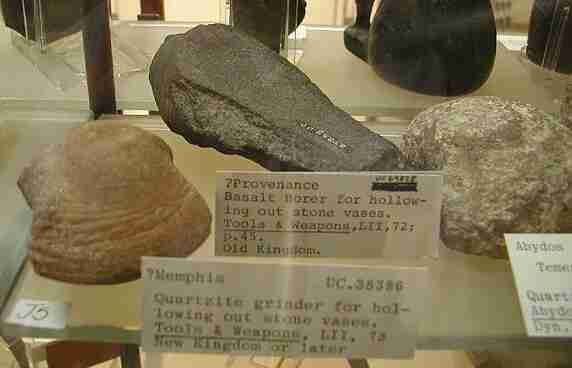
Round shaped stone borers used to make bowls with interiors no wider than the mouth are known from the ancient city of Ur in Mesopotamia (Woolley 1955). Inverted truncated cones notched on the upper surface, believed to be used to shape the stone vessel's mouth, are also known from Egypt (e.g. UC368, UC369, UC373, Stocks 1993). Crescent shaped flints were used to cut softstones, like gypsum, without sand abrasive (Fig 21b, e.g. UC6134, UC6135, Caton-Thompson & Gardner 1934). In the case of bowls with openings exhibiting an inward curing edges, Petrie (c1977) suggests a 2 piece, hinged grinding tool was used. Striations observed on the interior of ancient Egyptian stone vessels (Fig. 22) and on stone borers (e.g. UC367) are found to be both variable in width and depth (Stocks 1993). The experimental evidence of Stocks (2001) demonstrates that quartz sand is capable of producing striations when a force of 1 kg/cm2 is applied to the cutting surface of the grinding tool. Most vessel's interiors were left rough, exhibiting striations (Fig. 22) and ridges (Fig. 23) left from the hollowing process. In the case of bowls (e.g. UC41119, UC41187, UC41108, UC18153, UC15801) and thin-walled vessels (e.g. UC41156, UC41157) the interiors were usually worked to a finished state.Fig. 20. Stone borers use for vessel making. ( The Petrie Museum (from left to right: UC38386, UC69828, UC36878), Photograph by Jon Bodsworth The Egypt Archive)
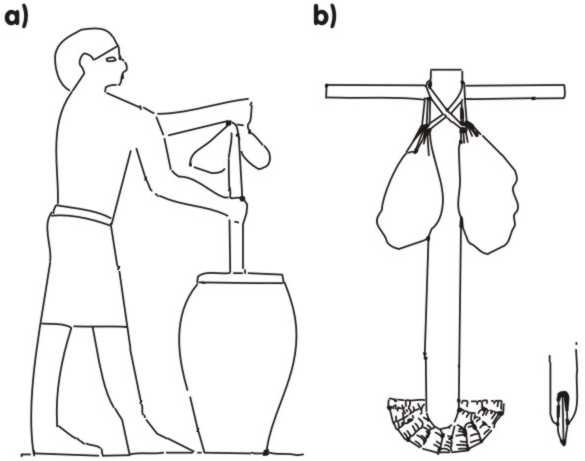
Fig. 21. a) Tomb representation of vase making using a boring tool. b) Tool reconstruction of borer used in gypsum vessel manufacturing (after Hodges 1964). Fig. 22. Theriomorphic travertine vessel in the form of pig or hippopotamus with interior surface striations, from the Naqada II period. (height 7.0 cm, The Petrie Museum (UC15754), Photograph by Jon Bodsworth The Egypt Archive) Fig. 23. A cross-sectioned Middle Kingdom travertine vessel from the Southern Pyramid at Mazghuneh. (The Manchester Museum, Photograph by Jon Bodsworth The Egypt Archive)
As with modern lapidary work, the ancient Egyptian's rock polishing techniques would be expected to vary depending on the type of rocks or minerals involved. The ability to polish a rock is dependent mainly on rock and mineral hardness. Generally, only hardrocks can be polished, such as most igneous, metamorphic, and hard sedimentary rocks. This is due to the fact that softrocks have less cohesion, and the mineral or sedimentary grains can be easily plucked from the surface during the working process, preventing a consistently smooth surface from being obtained. Hardrocks that contain mineral grains that are soft in terms of mineral hardness, such as travertine (calcite), are less difficult and time consuming to polish than rocks that contain hard minerals, like siliceous sandstone (quartz). Monomineralic rocks such as travertine, which are made almost entirely of calcite, pose little problem for polishing. Polymineralic rocks, like granite, made mostly of the two primary minerals, quartz and feldspar, pose more of a challenge due to the variability of hardness of these minerals. However, this problematic nature is not as much as one might expect, since the difference in hardness between quartz and feldspar is only about 20%. Today, amateur lapidists use hard flat laps in the process of polishing hardrocks like granite (Sinkankas 1984). These tools polish by removing the high points of surface irregularities and help prevent the pitting of the surface due to variations in mineral hardness.
A number of representations of rock polishing are presented in ancient Egyptian art (Fig. 24). The most common tool was a piece of rock called a polishing stone or stone rubber (e.g. UC2935, UC35657, UC35657, UC392, UC393, UC394, UC395, UC396, UC397, UC398) used for shaping, smoothing, and polishing. These can be rectangular or round shaped blocks of rock with a flat surface on one or more sides. Polishing stones shaped for specific purposes could also be used (e.g. UC5662). The ancient Egyptians made these tools out of a variety of rock types, including granite, basalt, and sandstone (Clark & Engelbach 1930). These tools could be rubbed by hand back and forth or in a circular motion in a set pattern across the surface of the stone object with or without abrasive. Larger versions of these tools are similar in some respects to the modern levigator (a 10" to 12" cast iron disk with a handle, used today with abrasives to smooth and polish the surface of lithographic plates (Virtual LITHOGRAPHY workshop). Smaller versions, in a variety of shapes, can be used in a way similar to modern files and rasps made of steel to smooth the surface of rock statues and other objects. In modern experiments of ancient stone working techniques, stone rubbers are generally used wet to prevent clogging of the grinding surface with rock dust, which lessens their effectiveness (Pond 1980).
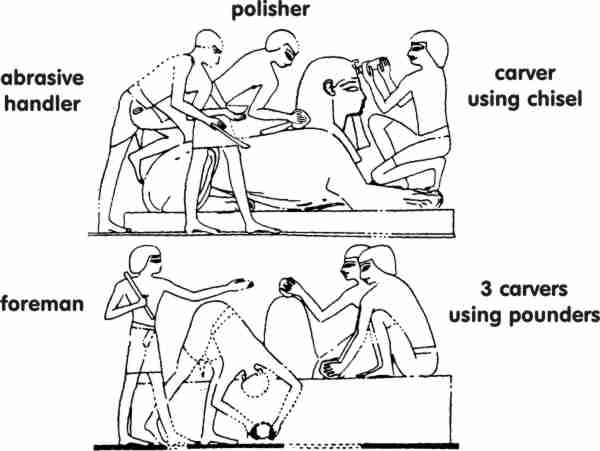
In some cases, the final stages of polishing would involve the use of loose abrasives. In modern times, generally coarse abrasives would be used first and applied with a soft lap (e.g. cloth or leather) in the case of softstones (i.e. rocks with minerals having hardnesses less than or equal to 3 on Mohs' Scale) or a hard lap (e.g. stone, wood, pitch, or copper/bronze/iron) for hardstones (i.e. rocks with minerals having hardnesses greater than or equal to 7 on Mohs' Scale). The ancient Egyptians would most likely follow similar techniques. The grain size of the abrasive would be reduced as the polish became finer. Metal oxides make ideal lapping abrasives, such as quartz (SiO2) and corundum (Al2O3), as well other material such as charcoal and pumice could also be used. The abrasive chosen would be dependent on the type of rock being polished. Quartz abrasive will work on rocks that contain quartz and feldspar; softstones would require abrasives with lower hardnesses than quartz so that control during the final stages of polishing could be more easily obtained. Quartz was readily available to the ancient Egyptians, but corundum (emery) appears to only be obtainable in sufficient quantities in late ancient Egyptian history (Lucas & Harris 1962, Arnold 1991).Fig. 24. Representation of teams of sculptors at work on a sphinx and a large stone altar. Some appear to be doing heavy work with round pounders/mauls, others are using polishing stones with an abrasive, from the tomb chapel of the vizier Rekhmire' at Thebes, 18th Dynasty (after Ruffle 1977, Clark & Engelbach 1930).
Stocks (1993) suggests that tailings from stone drilling and sawing by the ancient Egyptians could also be used as a fine polishing abrasive because of its 0.5-5 micron grain size. Today, a grain size of 5 microns (0.0002") is ideal for lapping gloss finishes on rock surfaces, since the transition from frosted to semigloss lapidary finishes occurs with abrasives about 15 micron in diameter, and high quality lapidary polishes are generally done with abrasive grain sizes of 6 (0.00025") to 0.5 microns (0.00002") (Craig & Vaughan, 1981). A discussion of very early mirror making at the Neolithic site of Çatalhöyük in central Anatolia can be found at the following website (GRINDING IT OUT).
Polishing of rocks is very tedious and time consuming and would have taken up a large amount of time during the manufacturing of stone vessels. The fine dust generated by these processes would also be damaging to the lungs of those involved in the work. An example of this is the poorly mummified remains of the 16 year old boy, Nakht, from Thebes, who's lungs exhibit signs of mild silicoses from polishing granite statues during the New Kingdom period (c.1100 BC). Interestingly, he may have been given the job of polishing granite as a punishment for a minor crime, demonstrating that it was not a particularly enjoyable or desirable job (See Webvideo Discussion).
Stocks (1993) has conducted experiments using hand-powered coring and boring drills during the manufacturing of a narrow-necked stone vessel made of limestone. This was based on the study of Old and New Kingdom period hieroglyphics representing boring tools (Fig. 21a) and the depiction of the apparent use of boring/coring tools in various tombs (Stocks 1986b). The completed limestone vessel was 10.7 cm tall, 10.0 cm in diameter, and has a neck opening about 5 cm in diameter. As exhibited in Stocks (2001), core drilling with a bow-powered drill produces a tapered core and core hole due to the reciprocal motion of the bow as it is drawn back and forth. When making stone vessels with thin walls this becomes a serious problem and the stresses generated by the wobbling of the drill shaft would generally lead to breaking of the vessel. In the manufacturing of stone vessels the rock core and the core hole walls must remain parallel. Stocks has demonstrated that a drill powered by hands alone alleviated the tapering problem associated with the bow-powered drills. Stocks (1988) found that if one hand was placed on the drill shaft and other hand powered the drill by a single curved handle, moved back and forth clockwise and anti-clockwise by 90o so that it returns to its starting position and the workman's starting position moves around the circumference of the vessel to keep the cutting even, the process produced a core with parallel sides. This method was termed by Stocks (1993) as the Twist-Reverse-Twist Drilling (TRTD) method.
The experiment in vessel making starts with the shaping of a block of limestone with copper chisels and adzes, flint chisels, punches, scrapers, and rubbers made of sandstone. The rough shaping of the vase took about 6.5 hours. When the rough shaping of the vase was complete Stocks drilled his centre hole using a copper barrel, coring drill with the TRDT method, after first cutting out circular guide grooves with flint chisels and scrapers to help center the drill. To make the removal of the centre core easier and less damaging to the vessel, 2 holes were cut with different diameter drills so that one hole was within the other (Fig. 25). The core was removed with a copper chisel and a mallet. The core drilling took about 5 hours to complete.

Fig. 25. Coring of the stone vessel's center hole using
two coring drills of different diameter.
The next stage involved using stone borers of various shapes and sizes to remove the rock from the inside of the vessel. The borer was inserted into the vessel through the neck opening (Fig. 26) and a layer of dry sand was poured into the bottom of the vase until the borer was covered.

A forked shaft was then inserted into the vessel and attached to the borer and then boring commenced (Fig. 27). It was found by Stocks (1988) that friction of the sand and jamming of the borer against the walls of the vase occurred when it was powered by a bow, and that the TRDT method worked best and did not jam. The TRDT method allowed both leverage and control to the cutting process making the job much easier. The interior was enlarged by using slightly larger borers than the diameter of the already existing vessel's interior.Fig. 26. Insertion of the figure eight shaped stone borer through vessel's center hole.

The cutting of the inner shoulder of the vessel was accomplished with hand-held, hook-shaped flint scrapers and hooked-shaped stone borers in combination with dry sand abrasive. The boring of the interior of the vessel took about 10 hours, and the undercutting of the vase's shoulder took an additional hour to complete.Fig. 27. Boring of the vessel's interior with stone borers of various sizes using quartz sand as an abrasive.
In total, the limestone vessel took about 22 hours 35 min. to complete without polishing. From his previous work, Stocks suggests that a vessel made out of granite of similar proportions and form would take about 75 hours to complete without polishing (Stocks, 1988). It was also suggested (Stocks 1993) that the manufacturing time can be reduced through experience, possibly by a factor of 2.
a) Introduction
b) Copper
slabbing saws
c) Copper
coring drills
b) Stone vase making
e) Bead making
f) Relief carving
g) Stone sculpture carving
h) Lapping and polishing
References
Adams, B. (1988) Predynastic Egypt, Shire, Aylesbury, 72 p.
Aldred, C. (1981) Egypt to the end of the Old Kingdom. Thames and Hudson, London, 143 p.
Arnold, D. (1991) Building in Egypt: pharaonic stone masonry. Oxford University Press, New York, 316 p.
Aston, B.G. (1994) Ancient Egyptian stone vessels: materials and forms. Heidelberger Orientverlag, Heidelberg, 196 p.
Bourriau, J. (1981) Umm el-Ga ab: pottery from the Nile Valley before the Arab conquest. Cambridge University Press, New York, 141 p.
Caton-Thompson, G. & Gardner, E.W. (1934) The desert Fayum v. 1-2. The Royal Anthropological Institute of Great Britain and Ireland, London, 167 p.
Clark, S. & Engelbach, R. (1930) Ancient Egyptian masonry. Oxford University Press, New York, 242 p.
Craig, J.R. & Vaughan, D.J. (1981) Ore microscopy and ore petrography. John Wiley & Sons, New York, 406 p.
Eaton-Krauss, M. (1984) The representations of statuary in private tombs of the Old Kingdom. Otto Harrassowitz, Wiesbaden, 208 p.
El-Khouli, A. (1978) Egyptian stone vessels. Predynastic period to dynasty III v.1-3, Verlag Philipp von Zabern, Mainz am Rhein.
Emery, W.B. (1949) Great Tombs of the First Dynasty: Excavations at Saqqara v.1. Goverment Press, Cairo, 157 p.
Engelbach, R. (1923) The problem of the obelisks, from a study of the unfinished obelisk at Aswan. G.R. Doran,, New York, 134 p.
Gardiner, A.H. (1964) Egyptian grammar. Oxford University Press, Oxford, 646 p.
Hodges, H.W.M. (1964) Artifacts: an introduction to primitive technology. F.A. Praeger, New York, 248 p.
Hoffman, M.A. (1979) Egypt before the pharaohs. Routledge & Kogan, London, 390 p.
Lauer, J-P. (1976) Saqqara: the royal cemetery of Memphis: excavations and discoveries since 1850. Thames and Hudson, London, 248 p.
Lilyquist, C. (1995) Egyptian stone vessels: Khian-Tuthmosis IV. Metropolitan Museum of Art, New York, 128 p.
Long, F. W. (1976) The creative lapidary: materials, tools, techniques, design. Van Nostrand Reinhold, New York, 136 p.
Lucas, A. & Harris, J.R. (1962) Ancient Egyptian materials and industries. E. Arnold, London, 523 p.
Manuelian, P. der (1981) Notes on the so-called turned stools of the New Kingdom. In Studies in Ancient Egypt, the Aegean and the Sudan: Essays in Honour of Dows Dunham (eds. W.K. Simpson and W.M. Davis). MFA, Boston, 125-8.
Nicholson, P.T. & Shaw, I. (2000) Ancient Egyptian materials and techniques. Cambridge University Press, New York, 702 p.
Petrie, W.M.F. (1883) The pyramids and temples of Gizeh. Field and Taer. London, 250 p. (e-book link)
Petrie, W. M. F. (c1970) Social life in ancient Egypt. Cooper Square Publishers, New York, 210 p.
Petrie, W.M.F. (c1974) Tools and weapons. Aris & Phillips, Warminster, UK, 71 p.
Petrie, W.M.F. (c1977) The funeral furniture of Egypt: with stone and metal vases. Aris & Phillips, Wiltshire, 65 p.
Pond, A. W. (1980) Primitive methods of working stone: based on experiments of Halvor L. Skavlem. Kraus Reprint, Millwood, N.Y., 143 p.
Quibell, J.E. & Green, F.W. (1902) Hierakonpolis. Part II. British School of Archaeology in Egypt Memoir 5. London.
Reisner, G.A. (1931) Mycerinus, the temples of the third pyramid at Giza. Harvard University Press, Cambridge (MA), 292 p.
Rich, J.C. (1970) The materials and methods of sculpture. Oxford Univ., New York, 416 p.
Ruffle, J. (1977) Heritage of the pharaohs: an introduction to Egyptian archaeology. Phaidon, Oxford, 224 p.
Sinkankas, J. (1984) Gem cutting: a lapidary's manual. Van Nostrand Reinhold, New York, 365 p.
Stocks D.A. (1986a) Tools of the ancient craftsman. Popular Archaeology, June, 25-29.
Stocks, D.A. (1986b) Egyptian technology II: stone vessel manufacture. Popular Archaeology, May, 14-18.
Stocks, D.A. (1988) Industrial technology at Kahun and Gurob: experimental manufacture and test of replica and reconstructed tools with indicated uses and effects upon artifact production. Unpublished Masters thesis, University of Manchester.
Stocks, D.A. (1993) Making stone vessels in ancient Mesopotamia and Egypt, Antiquity, 67, 596-603.
Stocks, D.A. (1999) Stone sarcophagus manufacture in ancient Egypt. Antiquity, 73, 918-22.
Stocks, D.A. (2001) Testing ancient Egyptian granite-working methods in Aswan, Upper Egypt. Antiquity, 75, 89-94.
Warren, P. (1969) Minoan stone vessels. Cambridge University Press, Cambridge, 280 p.
Woolley, C.L. (1955) Ur excavations v. IV. The Trustees of the British Museum and the Museum of the University of Pennsylvania, Philadelphia, London.
Zuber, A. (1956) Techniques du travail des pierres dures dans l'Ancienne Egypte. Techniques et Civilisations, 29, 161-95.
Links
Ancient Egyptian Stone Technology
Archaeology: An Official Publication of the Archaeological Institute of America
The Egypt Archive Jon Bodsworth's image archive of ancient Egyptian antiquities
"The Pyramids and Temples of Gizeh" Online
Virtual Lithography
Workshop Jane Apgar Sommers Equine Paintings, Etchings, Portraits,
and Prints